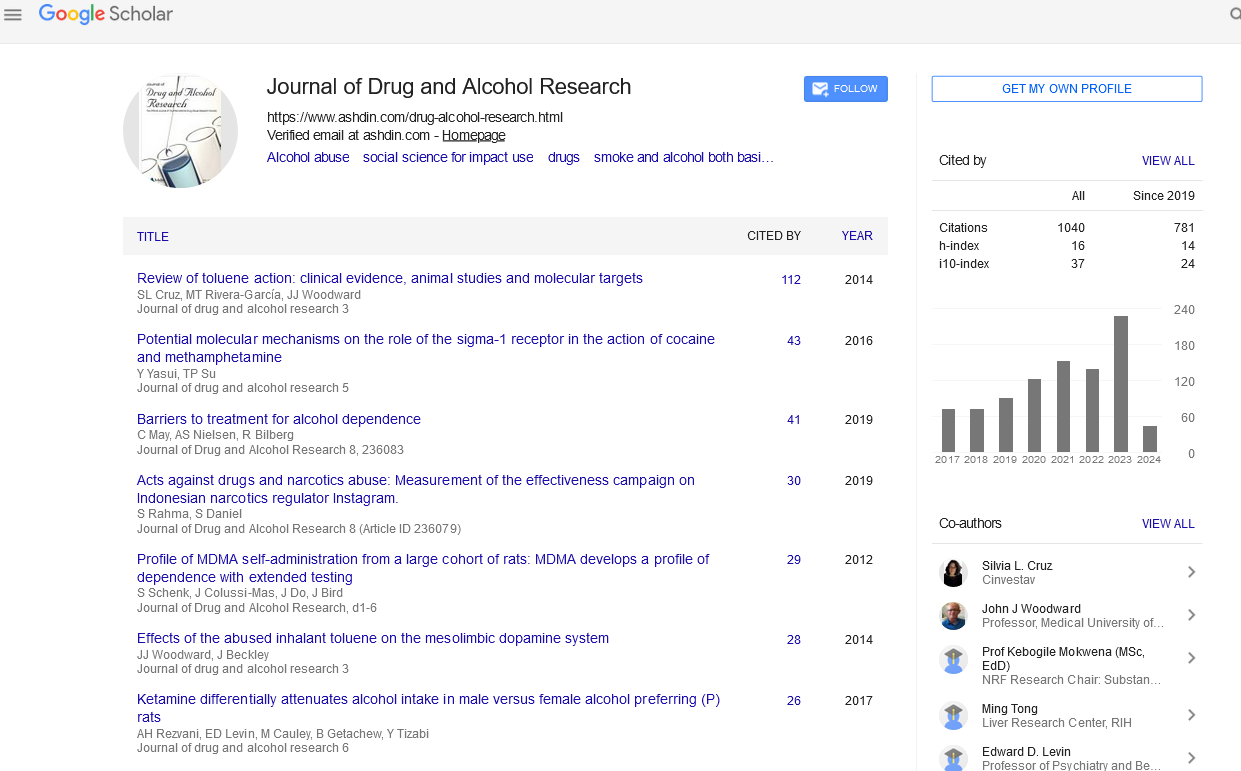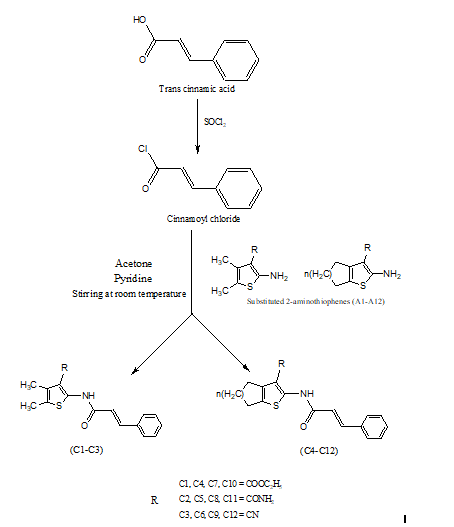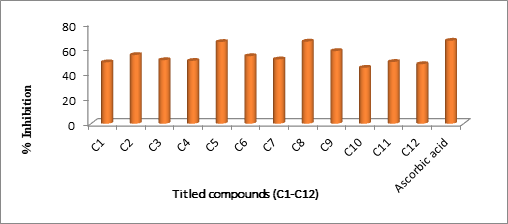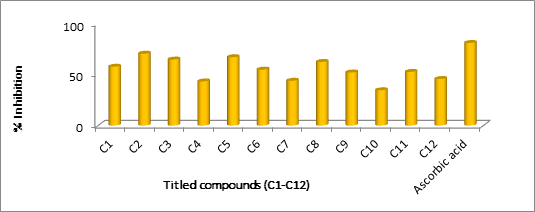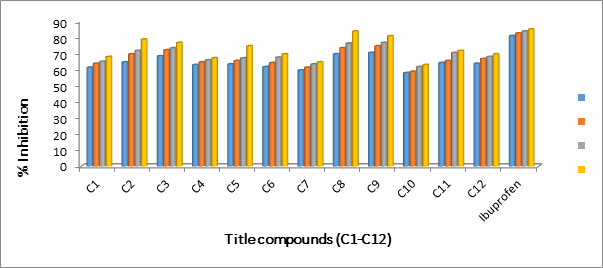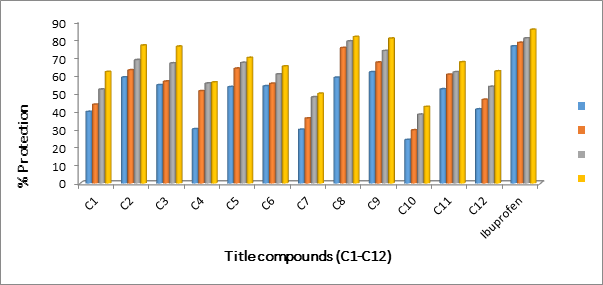Research Article - Journal of Drug and Alcohol Research ( 2024) Volume 13, Issue 12
Synthesis, Pharmacological Evaluation of Novel Cinnamamide Derivatives Containing Substituted 2-aminothiophenes
Satya Sree Bandaru1* and Madhavi Kuchana22Department of Pharmaceutical Chemistry, Institute of Pharmaceutical Technology, India
Satya Sree Bandaru, Department of Pharmaceutical Chemistry, V.V. Institute of Pharmaceutical Sciences, India, Email: satyasree.bandaru@gmail.com
Received: 02-Dec-2024, Manuscript No. JDAR-24-152068; Editor assigned: 04-Dec-2024, Pre QC No. JDAR-24-152068 (PQ); Reviewed: 18-Dec-2024, QC No. JDAR-24-152068; Revised: 23-Dec-2024, Manuscript No. JDAR-24-152068 (R); Published: 30-Dec-2024, DOI: 10.4303/JDAR/236421
Abstract
The novel cinnamamide derivatives (C1-C12) were synthesized by treating substituted 2-aminothiophenes (A1-A12) with cinnamoyl chloride (B) in the presence of mixture of pyridine and acetone at 0°C. The structures of the novel amide derivatives confirmed based on functional groups, number of protons, number of carbons and molecular weight from FT-IR, 1H-NMR, 13C-NMR and mass spectra respectively. Further, the synthesized compounds evaluated for in-vitro antioxidant activity by DPPH and Hydroxyl radical scavenging methods and in-vitro anti-inflammatory activity by Protein denaturation and HRBC membrane stabilization methods. The results revealed that all the synthesized compounds showed good in-vitro antioxidant and in-vitro anti-inflammatory activities with reference to the standard drugs, Ascorbic acid and Ibuprofen respectively. Among all, C8 and C9 compounds showed good in-vitro anti-inflammatory activity.
Keywords
Substituted 2-aminothiophene; Cinnamamide; In-vitro antioxidant; In-vitro anti-inflammatory
Introduction
Cinnamic acid is a α,β-unsaturated monocarboxylic acid and it is chemically 3-phenylacrylic acid, which found naturally in plants as phenolic acid, it has substantial antimicrobial effect against bacteria and fungi as well as antioxidant activity [1,2]. Ozagrel is an antiplatelet cinnamic acid containing marketed drug used therapeutically for treating acute ischemic stroke [3]. Derivatives of cinnamic acid also exhibit various biological activities like antiinflammatory and antimicrobial, anticancer, antiviral, antifungal, antidiabetic activities [4-6]. Among various derivatives of cinnamic acid, cinnamamide scaffold acts as a useful template for designing new drug-like molecules with potential pharmacological activity. Synthetic cinnamamides possess various biological activities like antioxidant and antimicrobial, anticancer, homeostatic, antiinflammatory and antidiabetic activities [7-11]. Structures of some reported natural and synthetic cinnamamides were depicted in Figure 1. Cinromide, Piplartine and Tranilast are marketed cinnamamides, Cinromide is an antiepileptic drug used to suppress generalized seizures, Piplartine is used as anticancer agent and Tranilast is used to treat bronchial asthma, allergic rhinitis [12-14]. The structures of these marketed drugs were depicted in Figure 2.
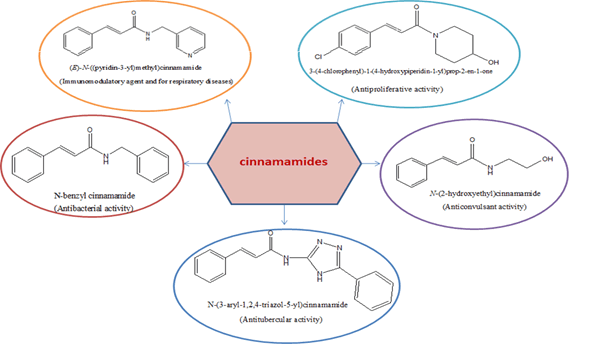
Figure 1: Structures of reported natural and synthetic cinnamamides
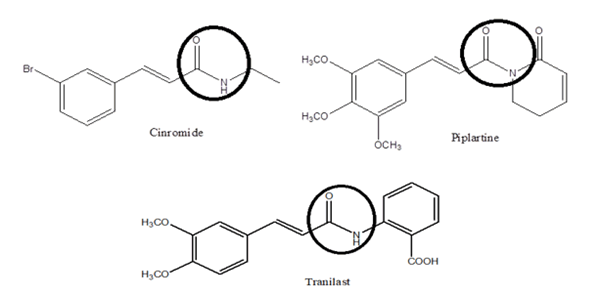
Figure 2: Marketed drugs containing substituted cinnamamide moiety
2-Aminothiophene scaffolds act as synthons for the synthesis of biologically active thiophene containing conjugates [15]. Numerous 2-aminothiophene derivatives have been the subject of recent investigation because they possess a wide variety of biological activities such as anti-inflammatory, anticancer, antimicrobial, antiviral, antiparasitic, antimalarial, antiproliferative, anticonvulsant, anti-tubercular activities [16-24]. Tinoridine, Tenidap, Tiaprofenic acid and Zileuton are thiophene containing marketed drugs with potent anti-inflammatory activity.
As per literature substituted 2-aminothiophenes and cinnamamides reported as potent anti-inflammatory agents. Therefore, the present study aimed to develop novel cinnamamide derivatives (C1–C12) by combining substituted 2-aminothiophenes with cinnamoyl moiety and the study also aimed to evaluate in-vitro antioxidant and anti-inflammatory activities.
Materials and Methods
Chemistry
Synthesis of substituted 2-aminothiophenes: Ketones like 2-butanone, cyclopentanone, cyclohexanone and cycloheptanone (0.01 mol), activated nitriles like ethyl cyanoacetate, cyanoacetamide and malononitrile (0.01 mol), sulfur (0.01 mol, 0.32 g) in 20 mL of ethanol were stirred at 50°C. To this mixture morpholine (0.025 mol, 2.16 mL) was added dropwise and stirring continued for another 3 h at ambient temperature. Further, the resultant solution left overnight in refrigerator and the obtained solid was filtered, dried and recrystallized from absolute ethanol. Synthesized substituted 2-aminothiophenes (A1-A12) were characterized by reported reference melting points [25, 26].
Synthesis of cinnamoyl chloride: Cinnamic acid (0.01 mol, 1.48 g) and of thionyl chloride (0.04 mol, 2.9 mL) were refluxed for about 5 h, excess of thionyl chloride was removed by distillation and the resultant precipitate used for next step without any purification [27].
General procedure for the synthesis of novel cinnamamide derivatives containing substituted 2-aminothiophenes: Cinnamoyl chloride in 10 mL acetone was added drop wise to a solution containing substituted 2-aminothiophene (A1-A12) (0.01 mol) and pyridine (0.01 mol) in 10 mL acetone, keeping the temperature at 0°C. The reaction mixture was stirred at room temperature for half an hour until the completion of reaction, monitored by TLC. The resultant precipitate was filtered, dried, and recrystallized from absolute ethanol. Further, all the synthesized compounds (C1-C12) were characterized by FT-IR, 1H-NMR, 13C-NMR and Mass spectra [27].
Ethyl-2-(cinnamamido)-4,5-dimethylthiophene-3- carboxylate (C1): Yellow solid, C18H19O3SN. IR [KBr film] cm-1:3270.11 (NH, str), 2928.51 (CH, str), 1762.68 and 1637.39 (C=O, str); 1H-NMR [400 MHz, CDCl3] δ:1.42-1.46 (t, 3H, O-CH2-CH3), 1.62 (s, 3H, CH3), 2.31 (s, 3H, CH3), 4.37-4.42 (q, 2H, O-CH2-CH3), 6.62-6.66 (d, 1H, CH=CH), 7.41-7.44 and 7.57-7.60 (m, 5H, Ar), 7.78-7.82 (d, 1H, CH=CH-Ar), 11.57 (s, 1H, NH); 13C-NMR [100 MHz, CDCl3] δ:12.46, 14.30, 14.38, 60.63, 112.87, 119.57, 123.98, 128.13, 128.93 (2C), 129.12 (2C), 130.25, 134.51, 143.42, 147.07, 162.48, 166.84; ES+APCI MS: m/z 330 (M+H)+.
2-(Cinnamamido)-4,5-dimethylthiophene-3- carboxamide (C2): Brown solid, C16H16O2SN2. IR [KBr film] cm-1:3268.13 (NH, str), 2940.91 (CH, str), 1652.83 (C=O, str); 1H-NMR [400 MHz, CDCl3] δ:1.64 (s, 3H, CH3), 2.33 (s, 3H, CH3), 6.63-6.67 (d, 1H, CH=CH), 7.42-7.45 and 7.58-7.61 (m, 5H, Ar), 7.79-7.83 (d, 1H, CH=CH-Ar), 11.59 (s, 1H, NH); 13C-NMR [100 MHz, CDCl3] δ:12.67, 14.51, 112.63, 115.54, 123.17, 128.04 (2C), 128.75 (2C), 130.09, 130.52, 134.28, 144.79, 146.98, 161.52, 169.32; ES+APCI MS: m/z 301 (M+H)+.
(E)-N-(3-Cyano-4,5-dimethylthiophen-2-yl) cinnamamide (C3): Brown solid, C16H14OSN2. IR [KBr film] cm-1:3259.27 (NH, str), 2936.83 (CH, str), 2208.41 (CN str), 1652.71 (C=O, str); 1H-NMR [400 MHz, CDCl3] δ:1.63 (s, 3H, CH3), 2.32 (s, 3H, CH3), 6.62-6.66 (d, 1H, CH=CH), 7.41-7.44 and 7.58-7.60 (m, 5H, Ar), 7.78- 7.82 (d, 1H, CH=CH-Ar), 11.58 (s, 1H, NH); 13C-NMR [100 MHz, CDCl3] δ:12.35, 14.72, 96.64, 112.98, 115.78, 123.56, 128.52 (2C), 128.98 (2C), 129.95, 130.79, 134.77, 143.93, 162.12, 170.32; ES+APCI MS: m/z 283 (M+H)+.
Ethyl-2-(cinnamamido)-5,6-dihydro-4H-cyclopenta[b] thiophene-3-carboxylate (C4): Light brown solid, C19H19O3SN. IR [KBr film] cm-1:3334.38 (NH, str), 2859.14 (CH, str), 1756.69 and 1606.02 (C=O, str); 1H-NMR [400 MHz, DMSO] δ:1.40-1.44 (t, 3H, O-CH2-CH3), 2.35-2.39 (m, 2H, CH2), 2.72-2.76 (t, 2H, CH2), 2.83-2.86 (t, 2H, CH2), 4.35-4.59 (q, 2H, O-CH2-CH3), 6.53-6.59 (d, 1H, CH=CH), 7.38-7.42 and 7.58-7.59 (m, 5H, Ar), 7.76-7.80 (d, 1H, CH=CH-Ar), 11.75 (s, 1H, NH); 13C-NMR [100 MHz, CDCl3] δ:14.27, 27.37, 27.50, 29.44, 60.49, 97.16, 119.53, 126.24, 128.08 (2C), 128.88 (2C), 129.91, 130.32, 134.47, 143.39, 157.62, 161.87, 175.24; ES+APCI MS: m/z 342 (M+H)+.
2-(Cinnamamido)-5,6-dihydro-4H-cyclopenta[b] thiophene-3-carboxamide (C5): Light brown solid, C17H16O2SN2. IR [KBr film] cm-1:3329.15, 3299.50 (NH, str), 2917.40 (CH, str), 1623.30 (C=O, str); 1H-NMR [400 MHz, DMSO] δ:2.36-2.39 (m, 2H, CH2), 2.73-2.77 (t, 2H, CH2), 2.84-2.87 (t, 2H, CH2), 7.11-7.15 (d, 1H, CH=CH), 7.44-7.50 and 7.64-7.65 (m, 5H, Ar), 7.74-7.77 (d, 1H, CH=CH-Ar), 11.74 (s, 1H, NH); 13C-NMR [100 MHz, CDCl3] δ:27.44, 27.57, 29.51, 97.23, 119.60, 126.31, 128.15 (2C), 128.95 (2C), 129.98, 130.39, 134.54, 143.46, 159.49, 161.94, 175.31; ES+APCI MS: m/z 313 (M+H)+.
(E)-N-(3-Cyano-5,6-dihydro-4H-cyclopenta[b] thiophen-2-yl)cinnamamide (C6): Yellow solid, C17H14OSN2. IR [KBr film] cm-1:3261.71 (NH, str), 2855.90 (CH, str), 2212.63 (CN, str), 1680.08 (C=O, str); 1H-NMR [400 MHz, DMSO] δ:2.35-2.39 (m, 2H, CH2), 2.73-2.76 (t, 2H, CH2), 2.83-2.87 (t, 2H, CH2), 7.13-7.17 (d, 1H, CH=CH), 7.44-7.49 and 7.64-7.65 (m, 5H, Ar), 7.74-7.77 (d, 1H, CH=CH-Ar), 11.75 (s, 1H, NH); 13C-NMR [100 MHz, CDCl3] δ:27.35, 27.48, 29.42, 95.14, 115.39, 119.51, 126.22, 128.06 (2C), 128.86 (2C), 129.89, 130.30, 134.45, 143.37, 161.85, 175.22; ES+APCI MS: m/z 295 (M+H)+.
Ethyl-2-(cinnamamido)-4,5,6,7-tetrahydrobenzo[b] thiophene-3-carboxylate (C7): Yellow solid, C20H21O3SN. IR [KBr film] cm-1:3245.81 (NH, str), 2940.98 (CH, str), 1752.03 and 1656.80 (C=O, str); 1H-NMR [400 MHz, CDCl3] δ:1.40-1.44 (t, 3H, O-CH2-CH3), 1.82-1.83 (d, 4H, -CH2-), 2.69-2.81 (d, 4H,-CH2-), 4.35-4.40 (q, 2H, O-CH2- CH3), 6.62-6.66 (d, 1H, CH=CH), 7.41-7.42 and 7.58-7.59 (m, 5H, Ar), 7.78-7.82 (d, 1H, CH=CH-Ar), 11.56 (s, 1H, NH); 13C-NMR [100 MHz, CDCl3] δ:14.35, 22.87, 23.00, 24.45, 26.42, 60.54, 111.77, 119.59, 127.41, 128.13 (2C), 128.93 (2C), 130.24, 131.00, 134.51, 143.43, 147.83, 162.46, 166.84; ES+APCI MS: m/z 356 (M+H)+.
2-(Cinnamamido)-4,5,6,7-tetrahydrobenzo[b] thiophene-3-carboxamide (C8): Yellow solid, C18H18O2SN2. IR [KBr film] cm-1:3445.99, 3328.71 (NH, str), 2941.73 (CH, str), 1678.64 (C=O, str); 1H-NMR [400 MHz, CDCl3] δ:1.58-1.59 (d, 4H, -CH2-), 2.51-2.53 (d, 4H, -CH2-), 6.45-6.50 (d, 1H, CH=CH), 7.40-7.47 and 7.49-7.56 (m, 5H, Ar), 7.58-7.61 (d, H, CH=CH-Ar), 11.23 (s, 1H, NH); 13C-NMR [100 MHz, CDCl3] δ:22.83, 22.97, 24.41, 26.38, 111.13, 119.82, 127.38, 128.07 (2C), 128.90 (2C), 129.97, 130.18, 134.48, 143.39, 161.57, 166.80, 167.84; ES+APCI MS: m/z 327 (M+H)+.
(E)-N-(3-Cyano-4,5,6,7-tetrahydrobenzo[b]thiophen-2- yl)cinnamamide (C9): Brown solid, C18H16OSN2. IR [KBr film] cm-1:3277.37 (NH, str), 2917.17 (CH, str), 2214.74 (CN, str), 1683.25 (C=O, str); 1H-NMR [400 MHz,CDCl3] δ:1.58-1.59 (d, 4H, -CH2-), 2.42-2.53 (d, 4H, -CH2-), 6.45- 6.49 (d, 1H, CH=CH), 7.42-7.43 and 7.56-7.58 (m, 5H, Ar), 7.77-7.81 (d, 1H, CH=CH-Ar), 11.53 (s, 1H, NH); 13C-NMR [100 MHz,CDCl3] δ:22.12, 23.36, 24.12, 24.52, 88.80, 115.44, 120.65, 128.31 (2C), 128.96 (2C), 130.65, 132.14, 132.36, 135.04, 145.67, 159.89, 165.85; ES+APCI MS: m/z 309 (M+H)+.
Ethyl-2-(cinnamamido)-5,6,7,8-tetrahydro-4Hcyclohepta[ b]thiophene-3-carboxylate (C10): Yellow solid, C21H23O3SN. IR [KBr film] cm-1:3230.47 (NH, str), 2923.22 (CH, str), 1736.37 and 1664.89 (C=O, str); 1H-NMR [400 MHz, CDCl3] δ:1.42-1.45 (t, 3H, O-CH2- CH3), 1.69-1.73 (m, 4H, CH2), 1.86-1.89 (qu, 2H, CH2), 2.76-2.78 (m, 4H, CH2), 4.37-4.43 (q, 2H, O-CH2CH3 ), 6.61-6.65 (d, 1H, CH=CH), 7.40-7.43 and 7.57-7.59 (m, 5H, Ar), 7.77-7.81 (d, 1H, CH=CH-Ar), 11.47 (s, 1H, NH); 13C-NMR [100 MHz, CDCl3] δ:14.29, 26.96, 27.83, 28.33, 28.67, 32.23, 60.73, 113.11, 119.61, 128.11 (2C), 128.92 (2C), 130.21, 131.65, 134.53, 136.58, 143.27, 145.80, 162.44, 166.91; ES+APCI MS: m/z 370 (M+H)+.
2-(Cinnamamido)-5,6,7,8-tetrahydro-4H-cyclohepta[b] thiophene-3 carboxamide (C11): Yellow solid, C19H20O2SN2. IR [KBr film] cm-1:3397.36, 3297.85 (NH, str), 2981.49 (CH, str), 1643.47 (C=O, str); 1H-NMR [400 MHz, CDCl3] δ:1.70-1.73 (m, 4H, CH2), 1.86-1.92 (qu, 2H, CH2), 2.73-2.78 (m, 4H, CH2), 6.76-6.79 (d, 1H, CH=CH), 7.41-7.42 and 7.58-7.60 (m, 5H, Ar), 7.78-7.83 (d, 1H, CH=CH-Ar), 11.12 (s, 1H, NH); 13C-NMR [100 MHz,CDCl3] δ:26.82, 27.79, 28.28, 28.62, 32.19, 112.51, 119.43, 128.12 (2C), 128.90 (2C), 130.05, 131.52, 134.23, 135.15, 143.19, 162.39, 165.92, 168.32; ES+APCI MS: m/z 341 (M+H)+.
(E)-N-(3-Cyano-5,6,7,8-tetrahydro-4H-cyclohepta[b] thiophen-2-yl)cinnamamide (C12): Light brown solid, C19H18OSN2. IR [KBr film] cm-1:3082.18 (NH, str), 2930.74 (CH, str), 2186.86 (CN, str), 1687.86 (C=O, str); 1H-NMR [400 MHz, CDCl3] δ:1.70-1.73 (m, 4H, CH2), 1.87-1.92 (qu, 2H, CH2), 2.74-2.79 (m, 4H, CH2), 6.76-6.80 (d, 1H, CH=CH), 7.42-7.43 and 7.59-7.61 (m, 5H, Ar), 7.81-7.85 (d, 1H, CH=CH-Ar), 9.14 (s, 1H, NH); 13C-NMR [100 MHz, CDCl3] δ:26.95, 27.81, 28.30, 28.64, 32.21, 112.76, 115.54, 119.54, 128.13 (2C), 128.91 (2C), 130.11, 131.59, 134.34, 136.18, 143.23, 162.72, 169.41; ES+APCI MS: m/z 323 (M+H)+.
Biological evaluation
In-vitro antioxidant activity: DPPH (2,2-diphenyl-1- picrylhydrazyl) free radical scavenging assay and hydroxyl radical scavenging activity were carried out to evaluate the in-vitro antioxidant activity as per the reference procedures for all the synthesized compounds (C1-C12) in comparison with reference standard Ascorbic acid [28,29].
DPPH free radical scavenging assay: DPPH free radical scavenging ability of the synthesized compounds (C1-C12) was carried out according to the reference procedure. Solutions of synthesized compounds at 100 μM concentration were added to 100 μM DPPH in 95% ethanol. The resultant solution was kept at an ambient temperature for 20 min and absorbance was measured at 517 nm. Ascorbic acid (100 μM) was used as reference. The percentage of DPPH free radical scavenging activity was calculated as per the following formula:

Hydroxyl radical scavenging activity
Hydroxyl radical scavenging ability of the synthesized compounds (C1-C12) was determined according to the reference procedure. Briefly, individual test compounds (1 mL) at 100 μM concentration was added to the reagent containing 1 mL FeSO4 (1.5 mM), 0.7 mL H2O2 (6 mM) and 0.3 mL sodium salicylate (20 mM) and incubated for 1 h at 37°C. Absorbance of the resulted solution was measured at 562 nm. Ascorbic acid was used as standard. The percentage scavenging was calculated according to the following formula:

Where A0 is control solution absorbance (containing all reagents except the test compound), A1 is test compounds absorbance with sodium salicylate and A2 is absorbance without sodium salicylate.
In-vitro anti-inflammatory activity
In-vitro anti-inflammatory efficacy of the synthesized compounds C1-C12 was performed by using Protein Denaturation Method and HRBC Membrane Stabilization Method in comparison with Ibuprofen as reference standard [30,31].
Protein denaturation method
Protein denaturation method was carried out by preparing the reaction mixture (0.5 mL) consist of 0.45 mL of bovine serum albumin (5 % w/v aqueous solution) and 0.05 mL of test samples of different concentrations (10 μg/mL, 25 μg/mL, 50 μg/mL and 100 μg/mL). For control solution 0.05 mL distill water was used instead of test sample, while product control solution lacked bovine serum albumin. The pH of the solution was adjusted to 6.3 using 1N hydrochloric acid. Above solutions were incubated at 37°C for 20 min and the temperature was increased to 57°C for 3 min. After incubation, solutions were allowed to cool and 2.5 mL of phosphate buffer saline was added. Ibuprofen was used as the standard. The absorbance was measured using UV-Visible Spectrophotometer at 416 nm. The percentage inhibition of protein denaturation was calculated as per the following formula:

HRBC membrane stabilization method
In HRBC membrane stabilization method Human Red Blood Cells (HRBC) suspension was prepared by collecting human blood from the volunteers and mixed with equal volume of sterilized Alsever solution (2% Dextrose, 0.8% Sodium citrate, 0.05% Citric acid and 0.42% Sodium chloride in water). The blood was centrifuged at 3,000 rpm for 10 min and packed blood cells rinsed thoroughly using isosaline solution thrice. The volume of blood cells was measured and reconstituted as 10 %v/v suspension with isosaline. The reaction mixture consists of 1 mL of phosphate buffer [pH 7.4, 0.15 M], 2 mL of hyposaline [0.36%], 0.5 mL of HRBC suspension [10% v/v] and 1 mL of test samples of various concentrations (10 μg/mL, 25 μg/mL, 50 μg/mL and 100 μg/mL). Ibuprofen was used as standard. Instead of hyposaline, 2 mL of distilled water was used as control to achieve 100% hemolysis. All the test solutions were incubated at 37°C for 30 min and centrifuged at 3,000 rpm for 20 min. The optical density of incubated solutions was measured at 560 nm. The percentage of HRBC membrane stabilization was calculated using the following formula:

Results and Discussion
Chemistry
In the present work, carboxylic group of cinnamic acid was converted into cinnamoyl chloride using thionyl chloride and condensed with substituted 2-aminothiophenes (A1- A12) in acetone as solvent consisting pyridine at 0°C to get various novel cinnamamide derivatives (C1-C12) in good yield. The structures of the synthesized compounds further confirmed by physical and spectral data (Figure 3).
Figure 3: Scheme-I: Schematic representation for the synthesis of novel cinnamamide derivatives containing substituted-2-aminothiophenes (C1-C12)
The structures of synthesized compounds (C1-C12) were deduced from FT-IR, 1H-NMR, 13C-NMR, Mass spectral analysis. The FT-IR spectra showed the absence of carboxylic acid and amine peaks, revealing the formation of proposed compounds and it was further confirmed by the appearance of absorption bands due to NH and C=O stretching vibrations of amide functional group. The absorption bands resulting from NH stretching that appear in the range of 3082.18 cm-1-3445.99 cm-1 and the carbonyl carbon of the amide functional groups was confirmed by the bands at 1606.02 cm-1-1687.86 cm-1. Compounds C1, C4, C7, and C10 had their ester functional group of carbonyl carbon confirmed by the band at 1736.37 cm-1–1762.68 cm-1, while compounds C3, C6, C9, and C12 had their nitrile functional group confirmed by the sharp band at 2186.86 cm-1–2214.74 cm-1. The 1H-NMR spectra of title compounds revealed the presence of protons of cinnamamido group connecting substituted thiophene. Protons of cinnamamido group appears in the following ranges, NH protons appears as singlet at δ 9.14-11.75; α,β- unsaturated alkene protons appears as 2 doublets between δ 6.45 and 7.85. The aromatic hydrogens appears as multiplet at δ 7.28-7.65; Substituted thiophene ring protons of synthesized compounds appears in the following ranges, protons of methyl groups at 4th and 5th position appears as singlet at δ 1.62-2.32 and protons of methylene group of cyclic analogues appears at δ 1.58-2.87; methyl group in ethyl esters shows triplet at δ 1.40-1.46 and the adjacent CH2 shows quartet at δ 4.35-4.59.
In 13C-NMR spectra, the carbonyl carbons of cinnamamido group were observed in the range of δ 146.98-166.80; 2 carbons conjugating with the carbonyl group appeared between δ 112.63 and 145.67. Aromatic carbons of cinnamamido group observed in the range of δ 128.04-128.11; alkyl carbons substituted on thiophene ring were observed in the range of δ 12.35-60.73; cyclic alkane carbons signal appeared at δ 22.12-32.23; carbons of thiophene ring appeared between δ 88.80 and 175.31; ester carbonyl carbon shows the signal at δ 145.80-157.62; amide carbonyl carbon signal appeared between δ 146.98 and 165.92 and nitrile carbon signal appeared at δ 112.76- 115.78; The mass spectra of all the synthesized compounds indicating their molecular weight.
Biological evaluation
In-vitro antioxidant activity: All the synthesized compounds tested for their antioxidant activity by DPPH and Hydroxyl radical scavenging activities at 100 μM concentration. The activity data depicted in Table 1. Among the evaluated compounds C8 and C5 are more active against DPPH radical. From the evaluated results it is observed that the compounds C2, C5, C8 and C11 were more active due to amide group at 3rd position on thiophene ring. Modification of this amide group to cyanide and ester group results in decreased activity. This indicates that the presence of amide functional group at 3rd position on thiophene ring played a greater effect on antioxidant activity. The comparative % inhibition at 100 μM concentration of synthesized compounds shown in Figures 4 and 5 respectively. The activity data of the compounds in hydroxyl radical scavenging activity was appeared similar to the activity data of DPPH scavenging assay.
Table 1: In-vitro antioxidant activity of C1-C12 against DPPH and hydroxyl radicals
| S. No. | Compound | % inhibition at 100 µM by DPPH method | % inhibition at 100 µM by Hydroxyl radical scavenging method |
|---|---|---|---|
| 1 | C1 | 48.98 | 57.81 |
| 2 | C2 | 54.78 | 70.53 |
| 3 | C3 | 50.72 | 64.8 |
| 4 | C4 | 50.14 | 43.4 |
| 5 | C5 | 65.21 | 67.1 |
| 6 | C6 | 53.91 | 54.92 |
| 7 | C7 | 51.3 | 44 |
| 8 | C8 | 65.5 | 62.43 |
| 9 | C9 | 57.97 | 52.02 |
| 10 | C10 | 44.63 | 34.7 |
| 11 | C11 | 49.27 | 52.7 |
| 12 | C12 | 47.53 | 45.7 |
| 13 | Ascorbic acid | 66.2 | 81.06 |
Figure 4: Comparative % inhibition values of C1-C12 by DPPH scavenging assay
Figure 5: Comparative % inhibition values of C1-C12 by hydroxyl radical scavenging activity
In-vitro anti-inflammatory activity: Protein denaturation is a marker for inflammatory diseases. In view of this percentage inhibition of protein denaturation was estimated by protein denaturation method for the synthesized compounds (C1-C12) at different concentrations (10 μg/ mL, 25 μg/mL, 50 μg/mL and 100 μg/mL). The percentage inhibition of protein denaturation data was presented in Table 2 and the comparative results depicted in Figure 6. From the results it was observed that the entire synthesized compounds exhibited good in-vitro anti-inflammatory activity, the increased activity observed with the increase in the concentration of test compounds. Among all C8 and C9 are active at all concentrations tested and noticed the highest inhibition 83.75% and 80.83% respectively at 100 μg/mL. In the HRBC membrane stabilization method percentage protection was measured for the synthesized compounds (C1-C12) and the results were given in Table 3 and the comparative results depicted in Figure 7. The evaluation of results revealed that among all the synthesized compounds C8 and C9 exhibited good anti-inflammatory activity and shown 81.35% and 80.43% protections respectively at 100 μg/mL. From the results it is observed that amide containing compounds exhibited greater activity, modification of amide to nitrile on thiophene ring slightly alters the invitro anti-inflammatory activity and the data also revealing the importance of amide and nitrile functional groups on thiophene ring.
Table 2: In-vitro anti-inflammatory activity of C1-C12 by protein denaturation method
| Compound | % Inhibition of protein denaturation at different concentrations | |||
|---|---|---|---|---|
| 10 µg/mL | 25 µg/mL | 50 µg/mL | 100 µg/mL | |
| C1 | 61.25 | 63.75 | 65 | 67.92 |
| C2 | 64.58 | 69.58 | 71.67 | 78.75 |
| C3 | 68.33 | 72.08 | 73.33 | 76.67 |
| C4 | 62.92 | 64.58 | 65.83 | 67.08 |
| C5 | 63.33 | 65.42 | 67.08 | 74.58 |
| C6 | 61.67 | 64.17 | 67.5 | 69.58 |
| C7 | 59.58 | 61.25 | 63.33 | 64.58 |
| C8 | 69.58 | 73.33 | 76.25 | 83.75 |
| C9 | 70.42 | 74.58 | 76.67 | 80.83 |
| C10 | 57.92 | 58.75 | 61.67 | 62.92 |
| C11 | 64.17 | 65.42 | 70.42 | 71.67 |
| C12 | 63.75 | 66.67 | 67.92 | 69.58 |
| Ibuprofen | 80.83 | 82.5 | 83.75 | 85 |
Table 3: In-vitro anti-inflammatory activity of C1-C12 by HRBC membrane stabilization method
| Compound | % Protection at different concentrations | |||
|---|---|---|---|---|
| 10 µg/mL | 25 µg/mL | 50 µg/mL | 100 µg/mL | |
| C1 | 39.76 | 43.74 | 52.15 | 61.93 |
| C2 | 58.87 | 62.85 | 68.51 | 76.61 |
| C3 | 54.59 | 56.58 | 66.67 | 75.99 |
| C4 | 30.13 | 51.23 | 55.51 | 56.12 |
| C5 | 53.52 | 63.77 | 66.98 | 69.73 |
| C6 | 53.98 | 55.36 | 60.56 | 64.99 |
| C7 | 29.82 | 36.09 | 47.86 | 49.85 |
| C8 | 58.72 | 75.22 | 78.9 | 81.35 |
| C9 | 61.78 | 67.13 | 73.55 | 80.43 |
| C10 | 24.16 | 29.51 | 38.23 | 42.51 |
| C11 | 52.3 | 60.4 | 61.78 | 67.28 |
| C12 | 41.14 | 46.49 | 53.67 | 62.24 |
| Ibuprofen | 76.11 | 78.09 | 80.54 | 85.34 |
Figure 6: Comparative percentage inhibition of C1-C12 by protein denaturation method
Figure 7: Comparative percentage inhibition of C1-C12 by HRBC membrane stabilization method
Conclusion
In conclusion, a series of novel cinnamamide derivatives containing substituted 2-aminothiophenes (C1–C12) were prepared using a conventional method. All the compounds were characterized by physical and spectral data. The synthesized compounds were screened for invitro antioxidant and in-vitro anti-inflammatory activity by comparing with a standard. In-vitro antioxidant results stated that all the compounds showed good antioxidant activity in DPPH and hydroxyl radical scavenging assays. The present study also revealed better in-vitro anti-inflammatory activity in protein denaturation and HRBC membrane stabilization methods. Among the series, the compounds C8 and C9 were found to exhibit significant in-vitro anti-inflammatory activity. The better activity of these compounds may be due to the amide or nitrile functional group at 3rd position on thiophene ring. The results of in-vitro anti-inflammatory activity were better correlated with the in-vitro antioxidant activity data revealing the importance of structural components of evaluated compounds. Since, these compounds possess good antioxidant and anti-inflammatory activities, further studies needed to be carried out to know their in-vivo antiinflammatory activity and acute toxicity.
Conflict Of Interest
Authors declare no conflict of interest.
Acknowledgement
One of the author Satya Sree B is thankful to V. V. Institute of Pharmaceutical Sciences for providing the necessary facilities to carry out this research work.
References
- J.D. Guzman, Natural cinnamic acids, synthetic derivatives and hybrids with antimicrobial activity, Mol, 19(2014):19292-19349.
- F. Natella, M. Nardini, M. Di Felice, C. Scaccini, Benzoic and cinnamic acid derivatives as antioxidants: Structure-activity relation, J Agric Food Chem, 47(1999):1453-1459.
- J. Zhang, J. Yang, X. Chang, C. Zhang, H. Zhou, et al. Ozagrel for acute ischemic stroke: A meta-analysis of data from randomized controlled trials, Neurol Res, 34(2012):346-353.
- M. Sova, Antioxidant and antimicrobial activities of cinnamic acid derivatives, Mini Rev Med Chem, 12(2012):749-767.
- P. De, M. Baltas, F. Bedos-Belval, Cinnamic acid derivatives as anticancer agents-a review, Curr Med Chem, 18(2011):1672-1703.
- N. Ruwizhi, B.A. Aderibigbe, Cinnamic acid derivatives and their biological efficacy, Int J Mol Sci, 21(2020):5712-5746.
- G. Seelolla, P. Cheera, V. Ponneri, Synthesis, antimicrobial and antioxidant activities of novel series of cinnamamide derivatives having morpholine moiety, Med Chem, 4(2014):778-783.
- M. Toolabi, S. Moghimi, T.O. Bakhshaiesh, S. Salarinejad, A. Aghcheli, 6-cinnamoyl-4-arylaminothienopyrimidines as highly potent cytotoxic agents: Design, synthesis and structure-activity relationship studies, Eur J Med Chem, 185(2020):1-13.
- W. Nong, A. Zhao, J. Wei, H. Cheng, X. Luo, et al. Synthesis of a series of benzothiazole amide derivatives and their biological evaluation as potent hemostatic agents, RSC Adv, 5(2018):6231-6241.
- D. Ribeiro, C. Proenca, C. Varela, J. Janela, E.J.T. da Silva, et al. New phenolic cinnamic acid derivatives as selective COX-2 inhibitors: Design, synthesis, biological activity and structure-activity relationships, Bioorg Chem, 91(2019):1-10.
- P. Phuwapraisirisan, T. Puksasook, J. Jong-Aramruang, U. Kokpol, Phenylethyl cinnamides: A new series of a-glucosidase inhibitors from the leaves of Aegle marmelos, Bioorganic Med Chem Lett, 18(2008):4956-4958.
- A.J. Wilensky, L.M. Ojemann, P.N. Friel, M.J. Almes, R.H. Levy, et al. Cinromide in epilepsy: A pilot study, Epilepsia, 24(1983):401-409.
- D.P. Bezerra, C. Pessoa, M.O.D. Moraes, N. Saker-Neto, E.R. Silveira, et al. Overview of the therapeutic potential of Piplartine (piperlongumine), Eur J Pharm Sci, 48(2012):453-463.
- S. Darakhshan, A.B. Pour, Tranilast: A review of its therapeutic applications, Pharmacol Res, 91(2015):15-28.
- M. Arya, A. Parveen, P. Sharma, G. Vishnoi, K. Gaur, et al. An updated review on synthetic features, chemical sciences, and pharmacological implications of the 2-aminothiophene derivatives, J Pharm Negat, 13(2022):1810-1825.
- H.M. Helal, M.A. Salem, M.A. Gouda, N.S. Ahmed, Design, synthesis, characterization, quantum-chemical calculations and anti-inflammatory activity of novel series of thiophene derivatives, Spectrochim Acta A Mol Biomol Spectrosc, 147(2015):73-83.
- R. Romagnoli, P.G. Baraldi, C.L. Lopez, M.K. Salvador, D. Preti, et al. Design, synthesis and biological evaluation of 3,5-disubstituted 2-amino thiophene derivatives as a novel class of antitumor agents, Bioorg Med Chem, 22(2014):5097-5109.
- H.M. Aly, N.M. Saleh, H.A. Elhady, Design and synthesis of some new thiophene, thienopyrimidine and thienothiadiazine derivatives of antipyrine as potential antimicrobial agents, Eur J Med Chem, 46(2011):4566-4572.
- S. Massari, G. Nannetti, L. Goracci, L. Sancineto, G. Muratore, et al. Structural investigation of cycloheptathiophene-3-carboxamide derivatives targeting influenza virus polymerase assembly, J Med Chem, 56(2013):10118-10131.
- D. Bosc, E. Mouray, S. Cojean, C.H. Franco, P.M. Loiseau, et al. Highly improved antiparasitic activity after introduction of an N-benzylimidazole moiety on protein farnesyltransferase inhibitors, Eur J Med Chem, 109(2016):173-186.
- R.T. Skerlj, C.M. Bastos, M.L. Booker, M.L. Kramer, R.H. Barker, et al. Optimization of potent inhibitors of P. falciparum dihydroorotate dehydrogenase for the treatment of malaria, ACS Med Chem Lett, 2(2011):708-713.
- A.C.V. Aguiar, R.O. Moura, J.F.B. Mendonca, H.A.D.O. Rocha, R.B. Gomes, Evaluation of the anti-proliferative activity of 2-aminothiophene derivatives against human cancer cells lines, Biomed Pharmacother, 84(2016):403-414.
- P.K. Kunda, J.V. Rao, K. Mukkanti, M. Induri, G.D. Reddy, Synthesis, anti-convulsant activity and in-silico studies of Schiff bases of 2-aminothiophenes via guanidine-catalyzed gewald reaction, Trop J Pharm Res, 12(2013):566-576.
- X. Lu, B. Wan, S.G. Franzblau, Q. You, Design, synthesis and anti-tubercular evaluation of new 2-acylated and 2-alkylated amino-5-(4(benzyloxy)phenyl) thiophene-3-carboxylic acid derivatives, Eur J Med Chem, 46(2011):3551-3563.
- S.C. Sunil, Y.P. Yogesh, J.J. Ananda, S.D. Mariam, Microwave accelerated synthesis of 2-aminothiophenes in ionic liquid via three component gewald reaction, Indian J Chem Sect B, 51(2012):653-657.
- M. Sridhar, M. Rao, N.H.K. Baba, R.M. Kumbhar, Microwave accelerated gewald reaction: Synthesis of 2-aminothiophenes, Tetrahedron Lett, 18(2007):3171-3172.
- A. Jitareanu, G. Tataringa, A.M. Zbancioc, C. Tuchilus, M. Balan, Cinnamic acid derivatives and 4-aminoantipyrine amidesâ??synthesis and evaluation of biological properties, Res J Chem Sci, 3(2013):9-13.
- K. Madhavi, K.V. Ramanamma, Synthesis and evaluation of ethyl 2-(2-cyano-3-(substituted phenyl)acrylamido)-4,5,6,7-tetrahydrobenzo[b]thiophene-3-carboxylates for antioxidant and antibacterial activities, Int J Curr Microbiol Appl Sci, 5(2016):364-375.
- S. Rajamanikandan, T. Sindhu, D. Durgapriya, D. Sophia, P. Ragavendran, et al. Radical scavenging and antioxidant activity of ethanolic extract of Mollugo nudicaulis by in-vitro assays, Ind J Pharm Edu Res, 4(2011):310-316.
- A. Ramya, N. Vijayakumar, M. Renuka, Antiarthritic effect of aqueous extract of lawsoniainermis.L-an in-vitro study, Int J Modn Res Revs, 3(2015):744-747.
- V. Kumar, Z.A. Bhat, D. Kumar, P. Bohra, S. Sheela, In-vitro anti-inflammatory activity of leaf extracts of Basella Alba linn. Var. Alba, Int J Drug Dev Res, 3(2011):176-179.
Copyright: © 2024 Satya Sree Bandaru, et al. This is an open access article distributed under the terms of the Creative Commons Attribution License, which permits unrestricted use, distribution, and reproduction in any medium, provided the original work is properly cited

